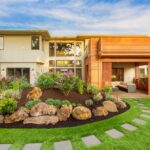Garden landscaping is a popular way for homeowners to enhance the beauty and functionality of their outdoor spaces. Through careful planning and design, a garden can be transformed into a serene oasis that reflects the homeowner’s personal style and preferences. Whether it’s creating a relaxing retreat or a vibrant gathering space, there are endless possibilities when it comes to landscaping a garden.
One of the key aspects of garden landscaping is selecting the right plants and flowers to create a cohesive and visually pleasing design. The choice of plants should be based on factors such as climate, soil type, and sun exposure. Different plants have different requirements, so it’s important to do some research before making any selections. Mixing a variety of colors, textures, and heights can add depth and interest to the garden and create a dynamic space that changes throughout the seasons.
In addition to choosing plants, landscaping also involves creating hardscapes such as pathways, patios, and seating areas. These elements can help define the layout of the garden and provide functional spaces for relaxation and entertainment. Materials such as stone, wood, and concrete can be used to create different looks and styles, whether it’s a rustic, natural feel or a modern, sleek design. Incorporating elements like water features, fire pits, and outdoor lighting can further enhance the overall ambiance of the garden.
Another important factor to consider in garden landscaping is the layout and circulation of the space. Paths and walkways should be strategically placed to create a sense of flow and guide visitors throughout the garden. The overall design should also take into account views and focal points, ensuring that there are visually appealing elements from every angle. By carefully planning the layout of the garden, homeowners can maximize the use of space and create a harmonious balance between plants and hardscapes.
Maintaining a well-landscaped garden requires ongoing care and attention. Regular watering, pruning, and weeding are essential to keep plants healthy and thriving. Mulching can help retain moisture and suppress weeds, while fertilizing can provide the necessary nutrients for optimal growth. It’s also important to monitor for pests and diseases and take proactive measures to prevent any issues that may arise. By investing time and effort into maintenance, homeowners can enjoy a vibrant and flourishing garden year-round.
Overall, garden landscaping is a creative and rewarding process that allows homeowners to express their personal style and create a beautiful outdoor space. By carefully selecting plants, incorporating hardscapes, and designing a functional layout, a garden can become a tranquil retreat that enhances the aesthetic value of any property. With proper maintenance and care, a well-landscaped garden can provide years of enjoyment and beauty for homeowners and visitors alike.
















